How An Indian Monk Bodhidharma Became The Father Of Kung-Fu
There are a lot of legends and stories that are being spread on the internet claiming to tell a new or unique information about the monk and his origins. But this story brings new light to the great monk’s story of how he became a monk from a prince.
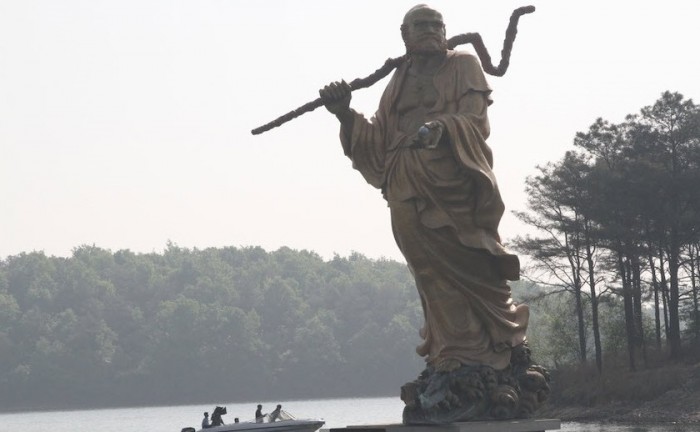
In 495 AD, the Indian monk Ba Tuo, or Buddhabhadra, came to China teaching a form of Buddhism known as Xiao Sheng Buddhism. He was given land at the foot of Shaoshi mountain by Emperor Shao Wen and founded the Shaolin Temple on this land. Around the time that Ba Tuo was founding the Shaolin Temple there was an Indian prince named Bodhidharma. Bodhidharma was very intelligent and was the favorite son of the king of a region that is now part of southern India.
Bodhidharma had two older brothers who feared that their father, the king, would pass them over and bequeath the kingship to Bodhidharma. In their jealousy, the two older brothers often disparaged Bodhidharma while talking with their father, hoping to turn him against their younger brother. The older brothers also attempted to assassinate Bodhidharma but Bodhidharma had very good karma and so the attempts were not successful.
Despite being the favorite son of the king, Bodhidharma realized that he was not interested in a life of politics. He chose instead to study with the famous Buddhist master Prajnatara and become a Buddhist monk.
China Was The Place His Master Wanted Him To Be
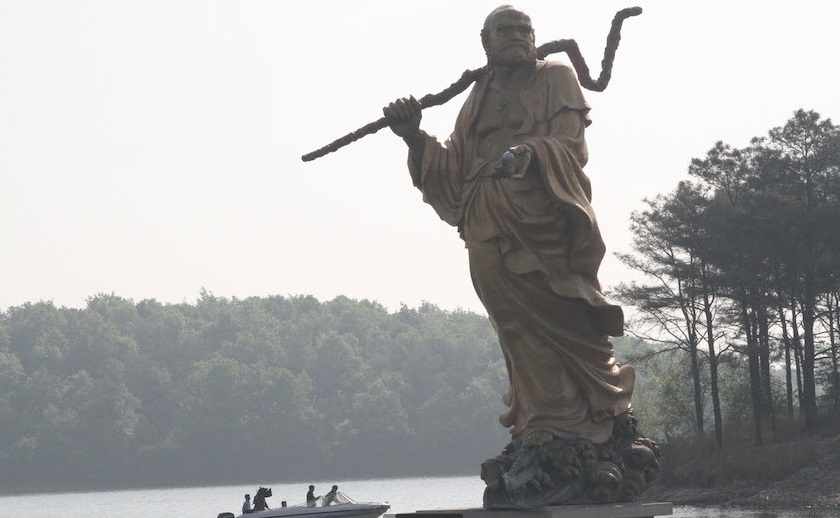
Bodhidharma trained with his master for many years. One day he asked his master, “Master, when you pass away, where should I go? What should I do?” His master replied that he should go to Zhen Dan, which was the name for China at that time. Years later, Bodhidharma’s master passed away and Bodhidharma prepared to leave for China.
During the many years that Bodhidharma had studied as a monk, one of his older brothers had become king of India and that older brother’s son had become king after him. The king of India was very fond of his uncle and wanted to make amends for the actions which Bodhidharma’s older brothers had taken against him. He asked Bodhidharma to stay near the capital, where he could protect and care for him, but Bodhidharma knew that he must go to China as his master had said.
Seeing that Bodhidharma would not remain, the king of India ordered that carrier pigeons be sent to China with messages asking the people of China to take care of Bodhidharma. These messages made Bodhidharma famous among many Chinese who wondered what was so special about this particular Buddhist monk that the king of India would make such a request.
In China He Was Popularly Known As Da Mo(The One Who Doesn’t Speak Much)
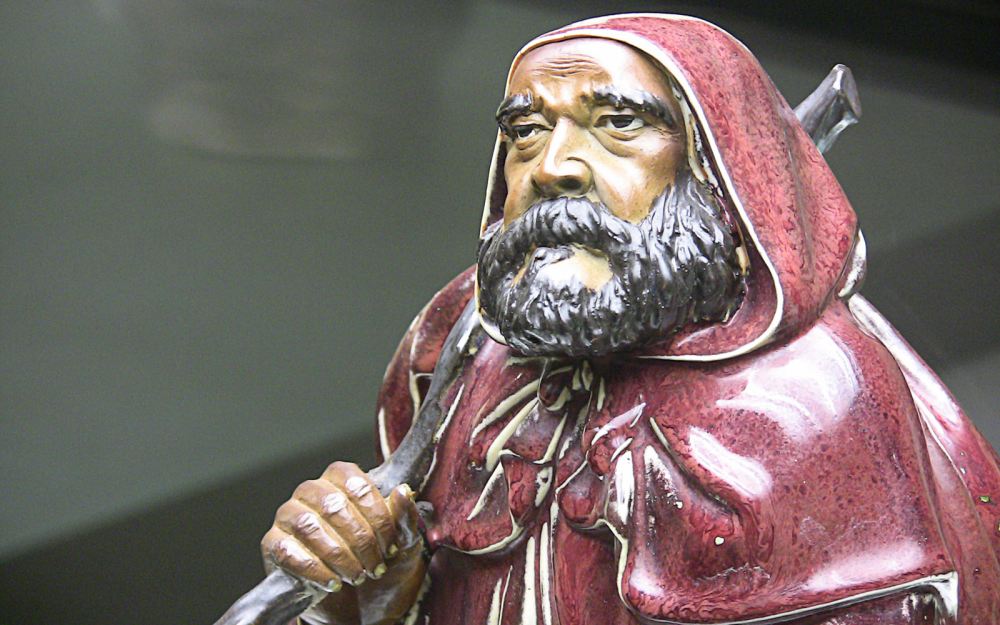
In 527 AD, 32 years after Ba Tuo’s founding of the Shaolin temple, Bodhidharma crossed through Guangdong province into China. In China, he was known as Da Mo. Da Mo arrived in China practicing Da Sheng (Mahayana) Buddhism. When Da Mo arrived, he was greeted by a large crowd of people who had heard of the famous Buddhist master and wished to hear him speak.
Rather than speak, Da Mo sat down and began meditating. He meditated for many hours. Upon completing his meditation, Da Mo rose and walked away, saying nothing.
His actions had a profound effect upon his audience. Some people laughed, some cried, some were angry and some nodded their heads in understanding. Regardless of the emotion, everyone in the crowd had a reaction.
Emperor Wu Invited Da Mo But Later Made Him Leave Because Of His Bitter Honesty
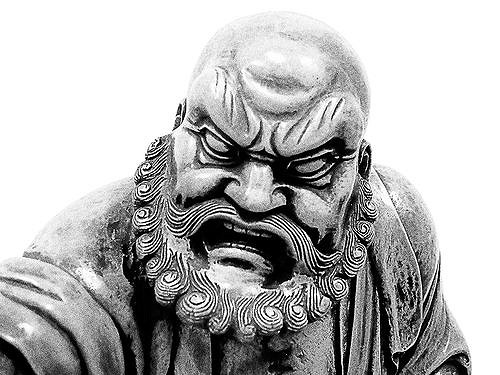
After hearing a lot about the Da Mo. Emperor Wu, who ruled over the southern kingdom of China, invited Da Mo to come to his palace. The emperor had erected many statues and temples devoted to Buddhism. He had given much wealth to Buddhist temples. In talking of his accomplishments, Emperor Wu asked Da Mo if his actions were good. Da Mo replied that they were not. Rather than seeking compliments, Emperor Wu should have been content to help his people through Buddha. This response surprised Emperor Wu, but they continued talking and eventually Emperor Wu asked Da Mo if there was Buddha in this world. Da Mo replied that there was not.
Similarly, if one asks if there is Buddha in the world, then one has already answered the question: Buddha is a matter of faith, you either believe in your heart or you do not. In questioning the existence of Buddha, Emperor Wu had demonstrated a lack of faith.
Da Mo’s answers enraged Emperor Wu and he ordered Da Mo to leave his palace and never return. Da Mo simply smiled, turned and left.
Da Mo Enlightened A Monk Named Shen Guang Who Broke His Teeth In Return
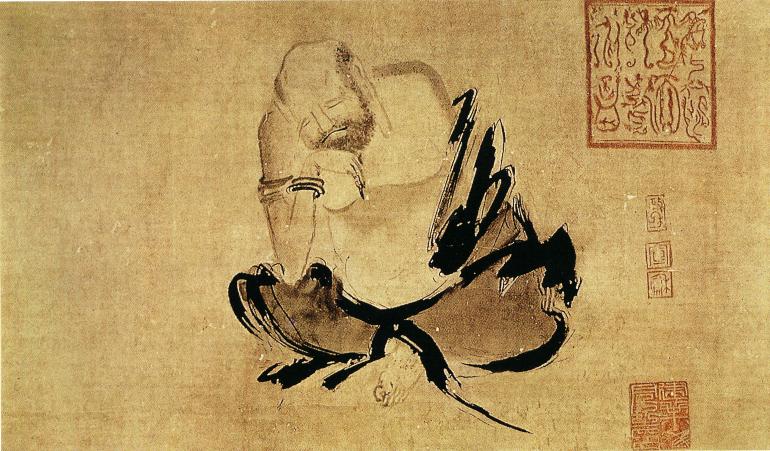
Near the Flower Rain Pavillion in Nanjing city, there was a large crowd of people gathered around a Buddhist monk, who was lecturing. This Buddhist monk was named Shen Guang.Shen Guang had at one time been a famous general. He had killed many people in battle but one day realized that the people he had been killing had family and friends and that one day someone might come and kill him. This changed him and he decided to train as a Buddhist monk.
Da Mo was amongst the crowd but some of his reactions were in disagreeing shake of the head which Shen Guang noticed. In anger, Shen Guang took the Buddhist beads from around his neck and flicked them at Da Mo. The beads struck Da Mo in his face, knocking out two of his front teeth. Da Mo immediately began bleeding. Shen Guang expected a confrontation; instead, Da Mo smiled, turned and walked away.
This reaction astounded Shen Guang, who began following after Da Mo.
An Old Woman As A Bodhisattva Helped Shen Guang Realize His Master In Da Mo
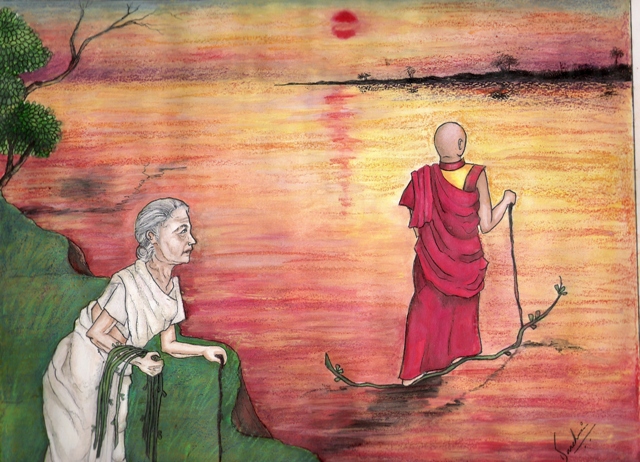
Da Mo continued north until he reached the Yangtze river. Seated by the river there was an old woman with a large bundle of reeds next to her. Da Mo walked up to the old woman and asked her if he might have a reed. She replied that he might. Da Mo took a single reed, placed it upon the surface of the Yangtze river and stepped onto the reed. He was carried across the Yangtze river by the force of his chi. Seeing this, Shen Guang ran up to where the old woman sat and grabbed a handful of reeds without asking. He threw the reeds onto the Yangtze river and stepped onto them. The reeds sank beneath him and Shen Guang began drowning.
The old woman saw his plight and took pity on Shen Guang, pulling him from the river. As Shen Guang lay on the ground coughing up river water, the old woman admonished him. She said that by not asking for her reeds before taking them, he had shown her disrespect and that by disrespecting her, Shen Guang had disrespected himself.
The old woman also told Shen Guang that he had been searching for a master and that Da Mo, the man he was following, was that master. As she said this, the reeds which had sunk beneath Shen Guang rose again to the surface of the river and Shen Guang found himself on the reeds being carried across the Yangtze river. He reached the other side and continued following after Da Mo.
Da Mo Taught Chan Buddhism Which Later Became An Integral Part Of The Shaolin Kung Fu
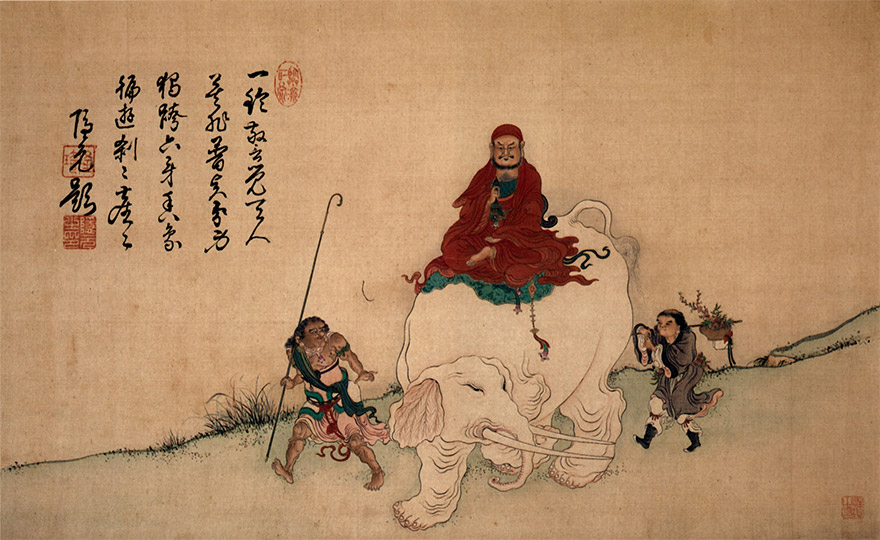
Da Mo sat facing a wall in the cave of the breast mountain behind shaolin temple and meditated for nine years. During these nine years, Shen Guang stayed outside Da Mo’s cave and acted as a bodyguard for Da Mo, ensuring that no harm came to Da Mo. Periodically Shen Guang would ask Da Mo to teach him, but Da Mo never responded to Shen Guang’s requests.
Shen Guang Waited Those Nine Years For Da Mo To Respond
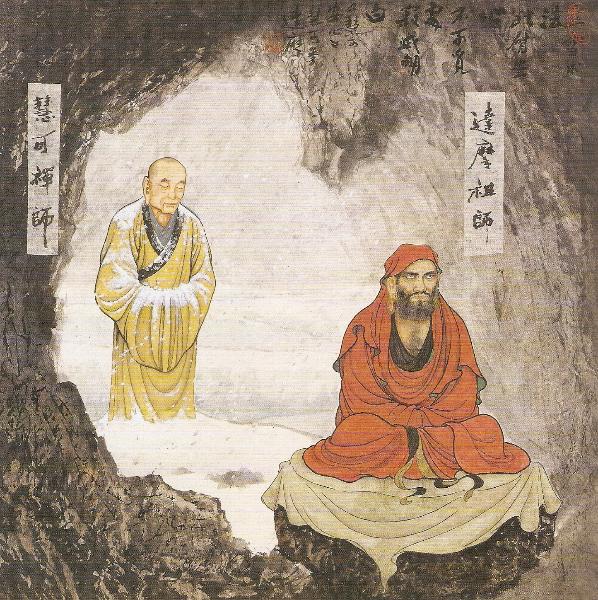
When the nine years of deep meditation ended Da Mo did not respond but he stood up, walked down to the room—that shaolin monks had made for him in the shaolin temple—sat down, and immediately began meditating. Shen Guang followed Da Mo to the Shaolin temple and stood guard outside Da Mo’s room. At the end of the four-year period Shen Guang had been following Da Mo for thirteen years, but Da Mo had never said anything to Shen Guang. It was winter when the four-year period was ending and Shen Guang in frustration picked up a large block of snow and ice and hurled it into Da Mo’s room. The snow and ice made a loud noise which awoke Da Mo from his meditation and he looked at Shen Guang. In anger Shen Guang demanded to know when Da Mo would teach him.
Da Mo responded that he would teach Shen Guang when red snow fell from the sky.
Hearing this, something inside Shen Guang’s heart changed and he took the sword he carried from his belt and cut off his left arm. He held the severed arm above his head and whirled it around. The blood from the arm froze in the cold air and fell like red snow. Seeing this, Da Mo agreed to teach Shen Guang.
Da Mo Agreed To Teach Shen Guang As His First Disciple Who Later Became Famous As Hui Ke
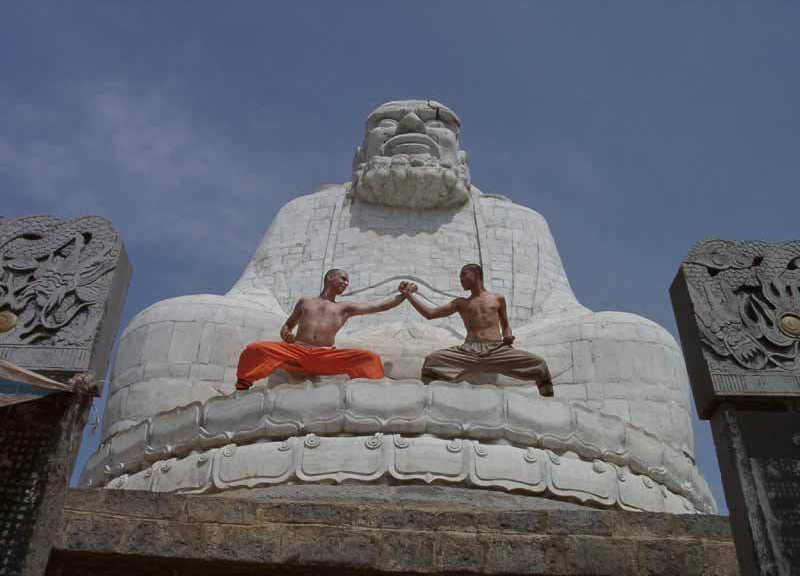
Da Mo took a monk’s spade and went with Shen Guang to the Drum Mountain in front of Shaolin Temple. The Drum Mountain is so called because it is very flat on top. Da Mo’s unspoken message to Shen Guang was that Shen Guang should flatten his heart, just like the surface of the Drum Mountain. Through the course of 4 years Da Mo dug four well with—Bitter, Spicy, Sour, and Sweet— water to survive a year per well from. It was an analogy of life which Shen Guang had realized at the end of the fourth and final year. Without really saying many words to Shen Guang, Da Mo had taught Shen Guang the most important of lessons in a mind-to-mind, heart-to-heart fashion. This mind-to- mind, heart-to-heart communication is called “action language” and is the foundation of the Chan Buddhism which Da Mo began at the Shaolin Temple.
After his realization, Shen Guang was given the name Hui Ke and he became abbot of the Shaolin temple after Da Mo. To pay respect for the sacrifice which Hui Ke made, disciples and monks of the Shaolin Temple greet each other using only their right hand.
Popular Posts
Top 10 Sharpest & Deadliest Swords In History
In classic mythological movies, books and television, we’ve seen those audacious sword-wielding heroes smiting the enemi...
Augustus Perez
List of Water Deities from Different Mythologies
Water deities are the gods and goddesses who had the powers to control the elements of water and ruled over all the fresh and saltwater of the earth. Here’s a list of water deities from different mythologies.
Rishika Gupta
Winged Lion: The Terrifying Mythical Creature In Different Mythologies
A mythological creature, a winged lion dates back to ancient times. This flying lion-like creature has origins in Heraldry, Christianity, Mesopotamian, and Greek mythologies.
Ethan Stephans








